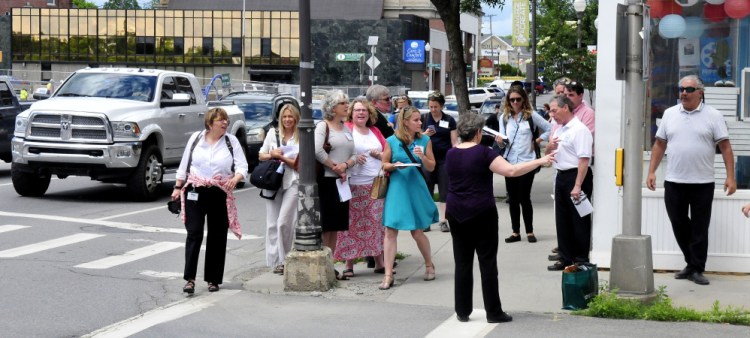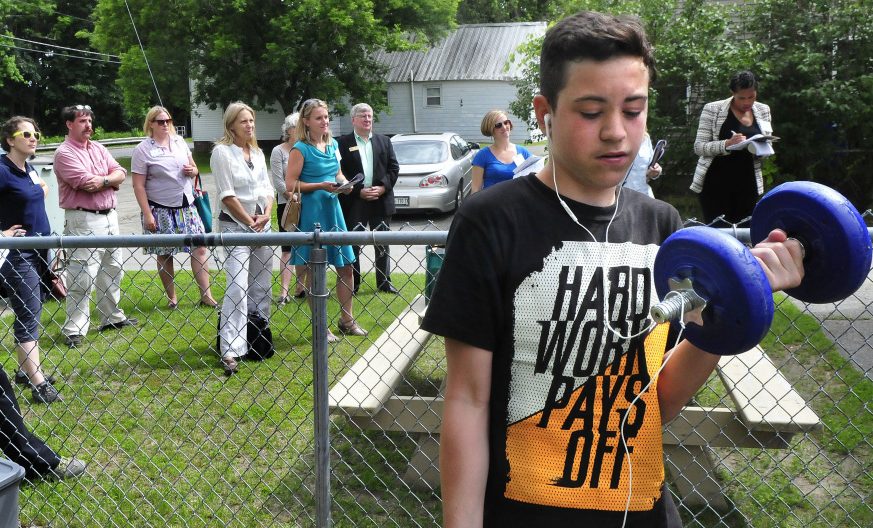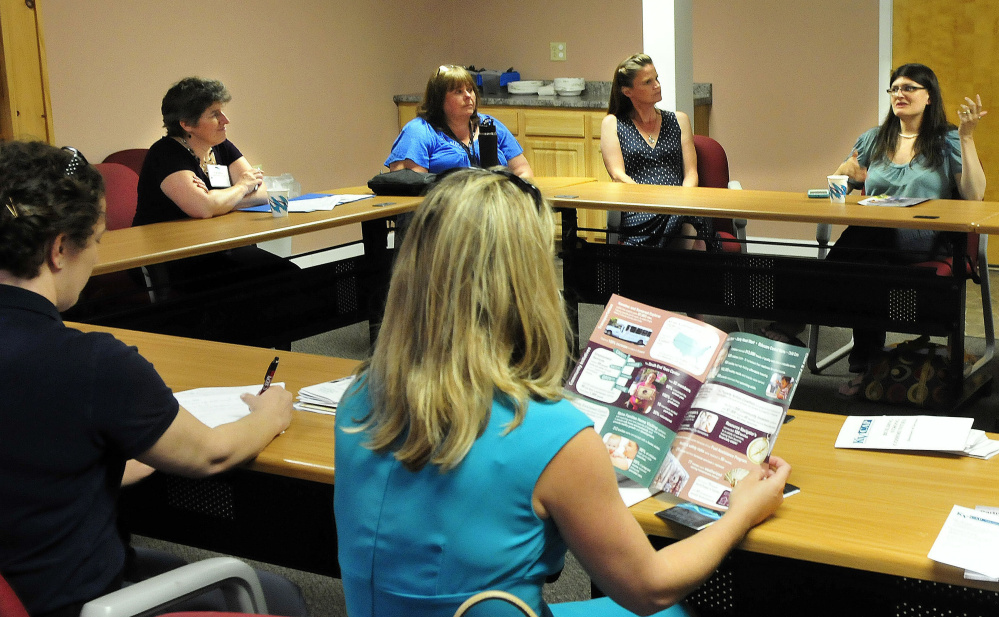WATERVILLE — Fran Mullin believes good health is the basis for everything in one’s life.
“Health starts where we live, learn, work and play,” she said, “and it is the foundation of our lives.”
Mullin, director of Healthy Northern Kennebec, touted her belief Tuesday at Colby College during a break in discussions among officials of her organization and other health agencies and institutions, including the U.S. Environmental Protection Agency, the U.S. Department of Housing and Urban Development, the U.S Department of Agriculture and the city, involved in an effort to improve the health of residents and make the Waterville region a thriving, economically viable place to live and work.
It was the second day of a two-day event called “Healthy Places for Healthy People,” a new EPA program in which an EPA team helps the community and health care facilities develop strategies and an action plan to address ways to improve the health of residents, public safety in the community, basic infrastructure and to create jobs.
Waterville was one of only 10 communities nationwide selected this year for the planning assistance program, for which 50 communities applied. Healthy Northern Kennebec applied for the program and Waterville was chosen as a site because of its commitment to advancing health efforts linked to community livability and economic diversification. Bangor also was chosen.
Health care facilities can be catalysts for economic development, and investment in neighborhoods can help improve walkability, protect air and water quality, conserve open spaces and natural resources and encourage cleanup and reuse of contaminated properties, EPA officials say.
More than 70 people turned out Tuesday at Colby’s Schair-Swenson-Watson Alumni Center to build on work they had done Monday during tours of the city and discussions at Senior Spectrum’s Muskie Center. On Tuesday, they heard presentations, took part in workshops and discussed implementing an action plan.
The biggest problem in Waterville is food access and food equity because of deep, persistent poverty, officials said Monday night. Limited transportation opportunities contribute to that, as do reductions in funding streams and perceived limitations of resources and assets. But Waterville has done a lot with limited funds and people power, according to EPA officials.
Mullin said Tuesday that the two days of activities were wonderful, and participants used words including “opportunity,” “cooperation,” “collaboration,” and “hope” to describe the event.
“People working across differences, I think, is really crucial; and we’re doing it, and it takes work,” Mullin said. “It’s not easy, but people are willing to do it because it’s worth it.”
Waterville’s participation in the program will be the basis for a case study the EPA will write up and use, and an action plan for reaching goals will be developed over the next three months, according to Mullin.
“We’ll have strategies and actions and ways to connect that are new, and an action plan that will guide us for the future.”
She said that Monday night, participants put forth a 20-year vision.
“We’re going to build a healthy community for Waterville, its people and the whole Northern Kennebec area,” she said.
A community, she said, is only as strong as its weakest person, and it should be everyone’s common goal to make sure that the person, whether young or old, has access to healthful food and good health care.
BRINGING PEOPLE TOGETHER
Healthy Northern Kennebec is a coalition that seeks to help improve public health by engaging the community in assessing needs and planning ways to succeed. Located at the Thayer Center for Health, which is part of MaineGeneral Health, the organization has more than 200 partners. It is working with Colby College, Inland Hospital and others to help revitalize downtown and ensure residents have access to healthful food, health care and economic opportunity.
Ellen Wells, community wellness leader at Inland Hospital, said Tuesday that she knows the group will come up with an action plan with short-term goals for long-term results, and that people in the community will launch the plan.
“The key is bringing people from all sectors representing the whole population to be involved,” she said. “It’s such a great opportunity. We’ve reached a tipping point here in Waterville.”
Jennifer Olsen, a consultant in her business, LocalFirst Group, and Waterville’s health and welfare director, Linda Fossa, said there was a lot of discussion about food insecurity and community connectivity, and the next step is implementing goals.
“What I believe is that nutrition, physical activity and community connections are the least expensive, most effective health care there is,” Olsen said. “What are we doing to model that in the community? This work up-levels both our thinking and our doing to a national example of what’s possible, and Waterville is ready.”
Olsen and Fossa both graduated from a program called The Community Health Improvement Leadership Academy through the Institute for Healthcare Improvement, they said. The focus was how to help make 100 million people’s lives healthier by the year 2020.
“So, it starts with, what would that take?” Fossa said. “What do I have to do to be inspired to make these kinds of changes in my community?”
Monica Niess, an EPA consultant to the community of Williamson, West Virginia, told the group Tuesday about efforts in that town to help improve the health of residents, create jobs and help rebuild the community and make it economically viable after the decline in the coal-mining industry there.
She said the idea is that you can help people to become healthier, but if there are no jobs, they can not remain so.
The program looked at health as an economic driver for the community, and a federally qualified health center was built downtown using unemployed former coal mine workers, who received training. The health center initially employed five people and now has 46 full-time employees. Local food programs were developed, workforce development was launched, a food hub was initiated and more jobs were created.
A local resident went to college to get a medical degree and returned to Williamson to be a primary care provider, Niess said. He saw a huge need among patients who were connected to the coal mining industry, whether they were former miners or their family members.
“As people started losing their jobs in the mine, they lost health insurance,” she said.
The doctor became a driving force for energizing other leaders in the community to step up to help, as no one can do it alone, Niess said. He helped people realize the potential of Williamson, met with local officials and led a grass-roots effort to build a culture of health over 10 years.
She said when she first went to Williamson, nobody was walking, hiking or bicycling in the town, and people did not go to parks.
“Now you go and it’s just incredible,” she said, adding that people run or walk downtown on their lunch hours.
“It’s really become a vibrant downtown area at night, which was absolutely desolate before,” she said.
The Waterville group set goals to identify programs, projects and places in the city that are key to increasing access to affordable, healthful food; to integrate community health, healthful eating and active living into ongoing downtown revitalization efforts; to inspire creative, collaborative partnerships to help improve local policies, systems and environments for healthful living for everyone; and to engage community members actively to incorporate public health and equity in planning and decision-making.
Amy Calder — 861-9247
Twitter: @AmyCalder17
Send questions/comments to the editors.





